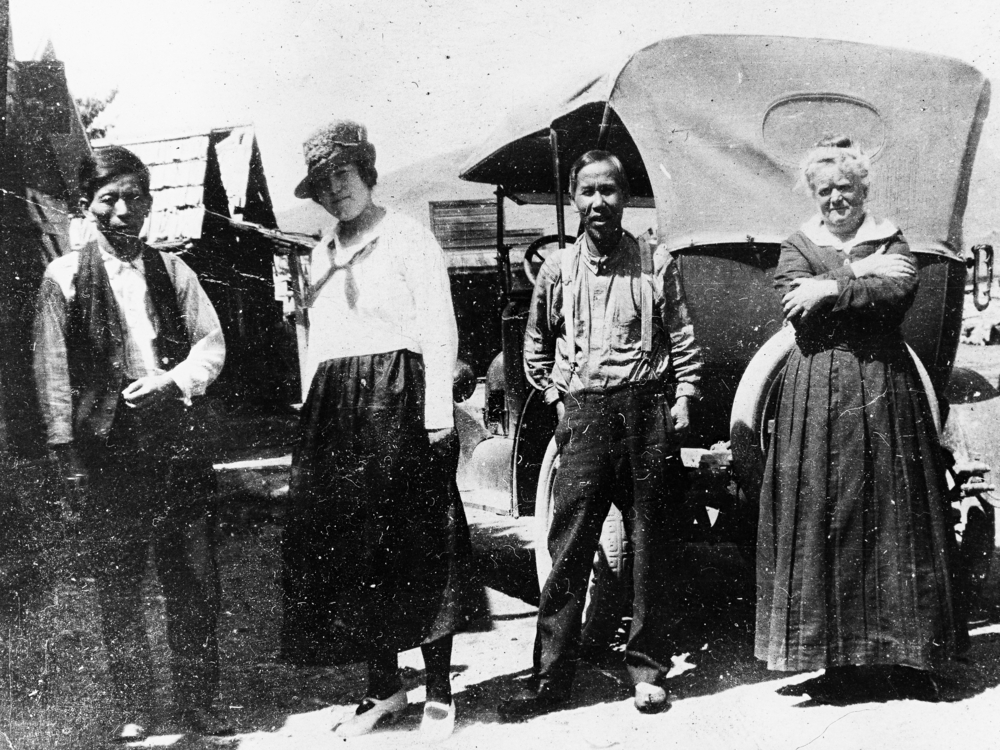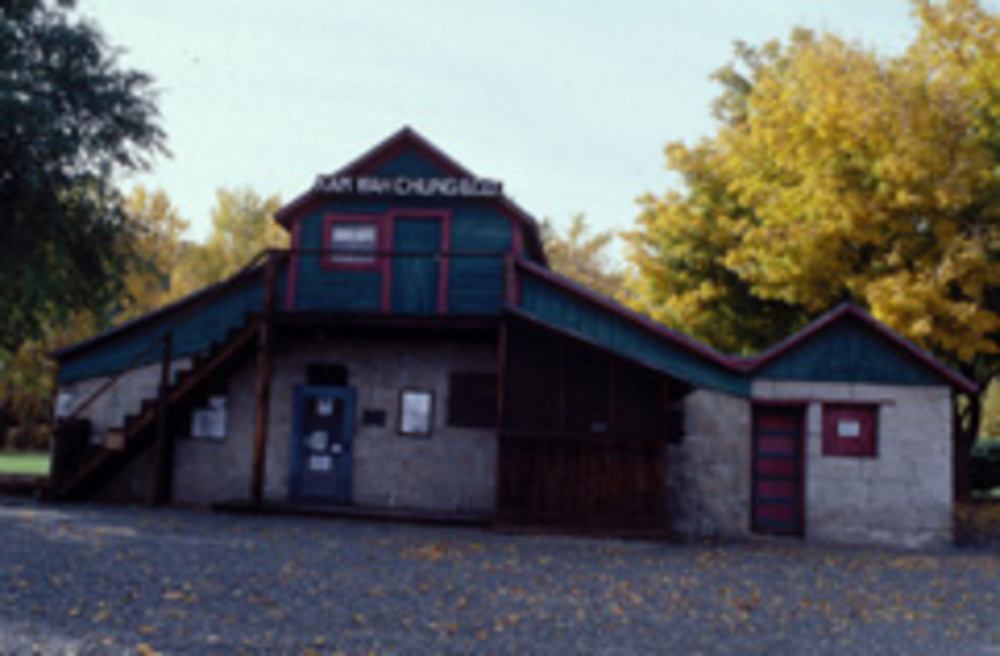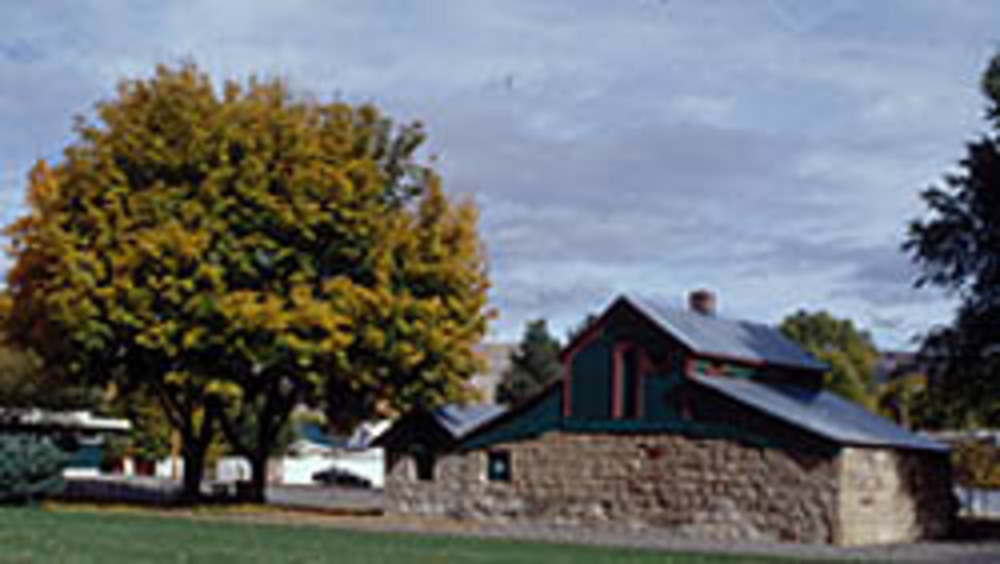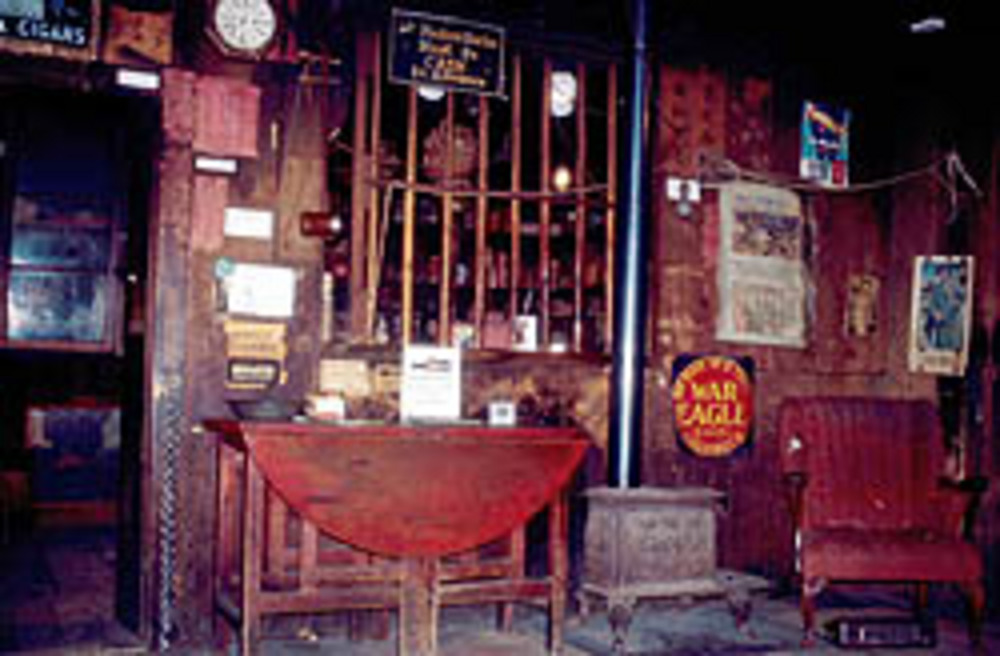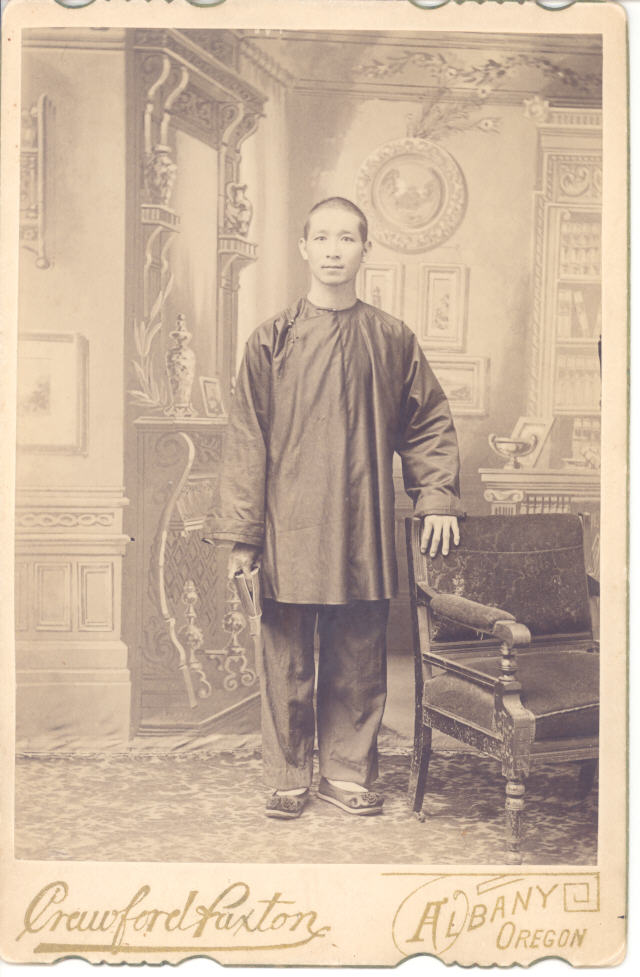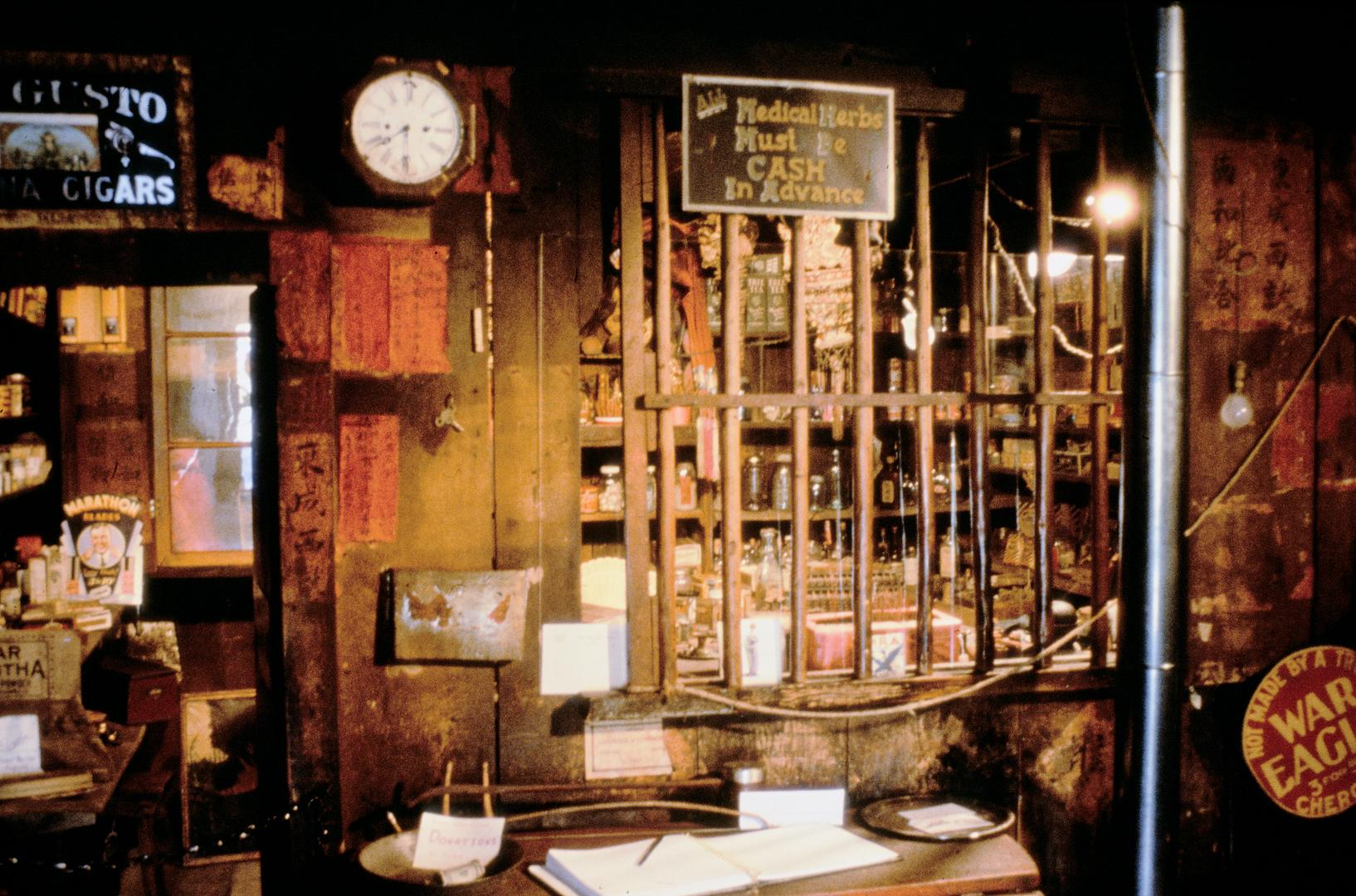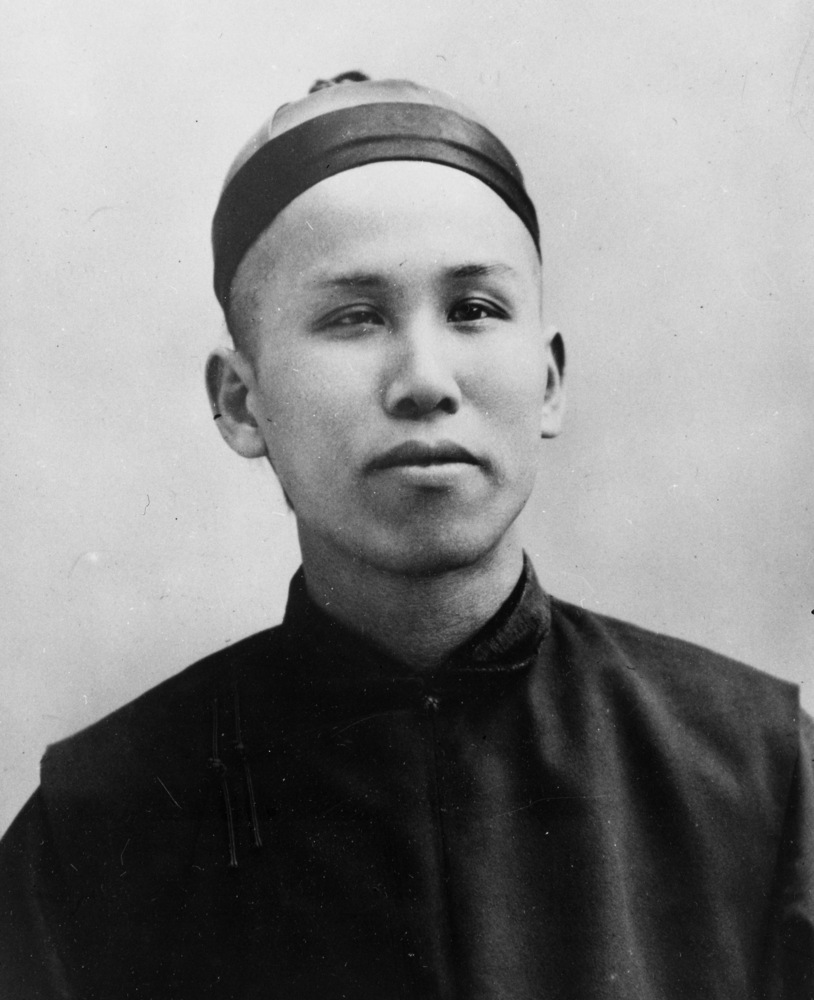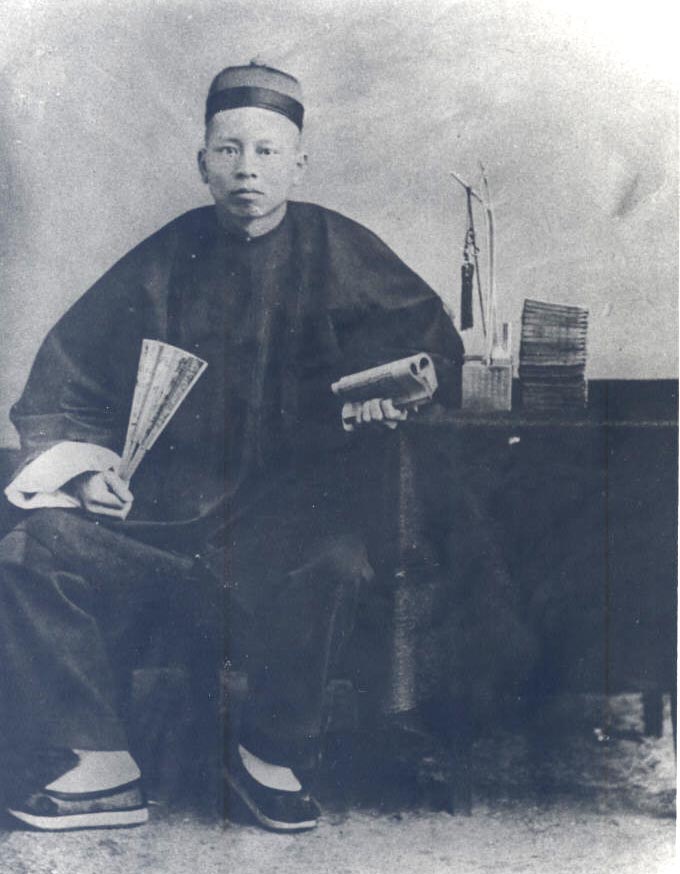The Kam Wah Chung and Company (Jin huachang ‘Golden Flower of Prosperity’) was a Chinese-owned grocery, dry goods store, and clinic in John Day. Built as a trading post along The Dalles Military Road in about 1866-1867, the store enjoyed a vigorous Chinese clientele and provided a gathering place for the Chinese community. It also functioned as a temple and joss house, unofficial post office, library, business and interpretive center, contract labor pool, automobile dealership, social club, dormitory, and apothecary shop. Established in 1871 as a contractor of Chinese labor, The Kam Wah Chung and Company operated during the height of Grant County’s influx of Chinese miners and laborers (1870-1910).
A business partnership formed in 1887 at The Kam Wah Chung with Chinese entrepreneur Lung On (Liang Guangyong, also known as Leon), Chinese herbalist Ing Hay (Wu Yunian, also known as Doc Hay), and, for a short while, Yee Nem. They formed this successful alliance against a backdrop of virulent anti-Chinese violence in the region. In 1885-1886, agitators had called for the expulsion of Oregon’s Chinese workers, which served as the platform to elect Sylvester Pennoyer governor of Oregon in 1886. Given this climate, the survival and longevity of the Kam Wah Chung, from its official re-opening in 1888 until it closed in 1948, are remarkable. It was the only Chinese-owned mercantile and apothecary store in eastern Oregon to have weathered both racism and the shift of its clientele to non-Chinese patrons.
An 1885 fire in nearby Canyon City’s Chinese quarter swelled the number of John Day’s resettled Chinese workers. By 1887, John Day’s Chinese community included three stores, a temple, a laundry, temporary housing, vegetable gardens, and a stocked fish and duck pond. The Kam Wah Chung building is all that remains of these structures. Constructed of light, porous stones from the region's Rattlesnake Tuff formation, the store was topped by a canted wooden roof; steel-hinged metal plates covered the window openings. The main floor interior had seven rooms, including a stock room and general store, private and bunk-style sleeping quarters, a kitchen, a common room, and an apothecary shop.
In addition to tools, clothing, and staples such as flour and sugar, The Kam Wah Chung sold imported goods such as rice, soy sauce, ginseng, patent Chinese medicine, and Chinese medicinal herbs. When it was legal, gum opium was sold, supplied by a Spokane, Washington, drug store. The Kam Wah Chung also sold liquor, and both pro- and anti-liquor factions lobbied Lung On for his support before Prohibition began in 1920.
Lung On contributed to the partnership with his business acumen, amiability, English skills, and thirst for new technologies, such as electricity and automobiles. Ing Hay’s medical skills—pulse diagnosis, the use of traditional Chinese herbal remedies, acupuncture, and moxibustion—made him vital to the health of the local, regional, and even national clientele he served. Ing Hay’s Chinese and non-Chinese patients hailed from places throughout Oregon and from states as distant as Alaska and Oklahoma.
The Kam Wah Chung’s financial success was such that Lung On’s estate was valued at almost $90,000 at the time of his death in 1940. Bob Wah, Ing Hay’s nephew, relocated to John Day in 1941 to apprentice with his uncle and help him run the clinic and apothecary shop. The Kam Wah Chung and Company closed in 1948.
In 1955, three years after the death of Ing Hay, Bob Wah deeded The Kam Wah Chung and Company building and its contents to the City of John Day to be used as a cultural museum. The building was closed up, with most of the contents intact. When volunteers reopened the building years later, there was still food in the kitchen, medicinal herbs and Doc Hay's tools on the apothecary table, and a stock of dry goods in the main room. In 1973, The Kam Wah Chung Company building was added to the National Register of Historic Places; the store opened as a museum in 1975. In 2005, The Kam Wah Chung Company site was named a National Historic Landmark.
The Kam Wah Chung, with its Chinese artifacts and more than 500 varieties of intact Chinese medicinal herbs, demonstrates the function and integration of Chinese medicine and medicinal practice in both the Chinese and non-Chinese communities in eastern Oregon. Personal and business letters, prescriptions, and account documents archived at the museum and at the Oregon Historical Society provide a rare and intimate view of the complex allegiances, difficulties, and challenges faced by Ing Hay, Lung On, and the Chinese clientele they served as they tried to preserve their Chinese community and ways of life in rural Oregon.
Interest in the long-term preservation of The Kam Wah Chung continues. After a large fundraising campaign and public investment, spearheaded in part by the Friends of The Kam Wah Chung and Oregon's first lady, Mary Oberst, the museum was refurbished and reopened in May 2008.
-
![Kam Wah Chung Company building.]()
Kam Wah Chung store.
Kam Wah Chung Company building.
-
![Lung On & Ing Hay with unidentified women, John Day.]()
Lung On & Ing Hay, ba019843.
Lung On & Ing Hay with unidentified women, John Day. Courtesy Kam Wah Chung & Co. Museum, John Day, and Oreg. Hist. Soc. Research Lib., ba019843
-
![Kam Wah Chung Company building, 1909.]()
Kam Wah Chung, 1909.
Kam Wah Chung Company building, 1909. Courtesy National Parks Service, National Historic Landmarks Coll.
-
![Kam Wah Chung Company Building Museum.]()
Kam Wah Chung museum, exterior 1.
Kam Wah Chung Company Building Museum. Courtesy National Parks Service, National Historic Landmarks Coll.
-
![Kam Wah Chung Company Building Museum.]()
Kam Wah Chung museum, exterior 2.
Kam Wah Chung Company Building Museum. Courtesy National Parks Service, National Historic Landmarks Coll.
-
![Interior, Kam Wah Chung Company Building Museum.]()
Kam Wah Chung museum, interior 3.
Interior, Kam Wah Chung Company Building Museum. Courtesy National Parks Service, National Historic Landmarks Coll.
Related Entries
-
![Chinese Americans in Oregon]()
Chinese Americans in Oregon
The Pioneer Period, 1850-1860 The Cantonese-Chinese were the first Chi…
-
![Edward Wah (1931?-2008)]()
Edward Wah (1931?-2008)
Edward Eng Wah, D.M.D., practiced dentistry in both Portland and John D…
-
![Expulsion of Chinese from Oregon City, 1886]()
Expulsion of Chinese from Oregon City, 1886
On February 22, 1886, approximately forty men gathered in Oregon City a…
-
![Ing Hay ("Doc Hay") (1862-1952)]()
Ing Hay ("Doc Hay") (1862-1952)
Ing Hay (Wu Yunian), also known as Doc Hay, was a partner of Kam Wah Ch…
-
![Lung On (1863-1940)]()
Lung On (1863-1940)
Lung On (Liang Guanying, also known as Leon) was a partner with Ing Hay…
Related Historical Records
Map This on the Oregon History WayFinder
The Oregon History Wayfinder is an interactive map that identifies significant places, people, and events in Oregon history.
Further Reading
Chen, Chia-Lin, A Gold Dream in the Blue Mountains: A Study of the Chinese Immigrants in the John Day Area, Oregon, 1870-1910. Portland: Portland State University, 1972.
Chen, Ying-Ju , and Jodi Varon, trans. “The Invisible Men of Gold Mountain.” In Talking on Paper: An Anthology of Oregon Letters and Diaries. Edited by Shannon Applegate and Terence O’Donnell. Corvallis: Oregon State University Press, 1994.
Yung, Judy et al. Chinese American Voices: From the Gold Rush to the Present. Berkeley: University of California Press, 2006.


